M1 helmet
The M1 helmet is a combat helmet that was used by the United States' military from World War II until 1985, when it was succeeded by the PASGT helmet. The M1 helmet has become an icon of the US military, with its design inspiring other militaries around the world.
| M1 helmet | |
|---|---|
 Refurbished M1 helmet with liner and helmet cover shown | |
| Type | Combat helmet |
| Place of origin | United States |
| Service history | |
| In service | 1941–1985 (US) |
| Used by | See Users for details |
| Wars | World War II Korean War First Indochina War Vietnam War Cambodian Civil War Laotian Civil War Portuguese Colonial War Lebanese Civil War Iran-Iraq War Falklands War United States invasion of Grenada Gulf War |
| Production history | |
| Designer | Major Harold G. Sydenham[1] |
| Manufacturer | McCord Radiator and Manufacturing Company and Schlueter Manufacturing Company[2] Ulbrichts Witwe |
| No. produced | 22 million (1945)[2] |
History
The M1 helmet was adopted in 1941 to replace the outdated World War I-era designed M1917A1 "Kelly" helmet[3] after research was done by Major Harold G. Sydenham.[1] Over 22 million U.S. M1 steel helmets were manufactured through September 1945.[4] Production was done by McCord Radiator and Manufacturing Company and Schlueter Manufacturing Company.[2]
A second US production run of approximately one million helmets was made in 1966–1967. These Vietnam War–era helmets were different from the World War II/Korean War version by having an improved chinstrap, and were painted a light olive green. The M1 was phased out during the 1980s in favor of the PASGT helmet,[5] which offered increased ergonomics and ballistic protection. No distinction in nomenclature existed between wartime front seams (so-called due to the location of the seam on the helmet's brim) and post war, or rear seam, shells in the United States Army supply system, hence World War II shells remained in use until the M1 was retired from service. The McCord Radiator and Manufacturing Company managed to learn how to create an almost eighteen-centimetre deep bowl in a single pressing, which was an engineering milestone at the time.[6]
While obsolete in the United States, the M1 Helmet and international variants are still in use by other nations around the world. The M1 helmet liner still occupies a symbolic niche in the United States military. For example, liners are currently worn in training by United States Navy SEALs BUD/S candidates and labeled with the trainees' class number, name, and rank insignia, while painted and chrome-plated versions are still used in ceremonial units. In Israeli service, reserve soldiers have used the M1 helmet in combat as late as 2006.
Design
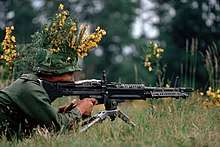

The M1 is a combination of two "one-size-fits-all" helmets—an outer metal shell, sometimes called the "steel pot", and a hard hat–type liner nestled inside it featuring an adjustable suspension system. Helmet covers and netting would be applied by covering the steel shell with the extra material tucked inside the shell and secured by inserting the liner.
The outer shell should not be worn by itself. The liner can be worn by itself, providing protection similar to a hard hat, and was often worn in such fashion by military policemen, Assistant Drill Instructors (known as AIs), and rifle/machine gun/pistol range staff, although they were supposed to wear steel at the range. The liner is sometimes worn in U.S. military ceremonies and parades, painted white or chromed. The depth of the helmet is 7 inches (180 mm), the width is 9.5 inches (240 mm), and length is 11 inches (280 mm), the thickness is 1/8" (3 mm), The weight of a World War II–era M1 is approximately 2.85 pounds (1.29 kg), including the liner and chinstrap.
Shell
Construction
The non-magnetic Hadfield manganese steel for M1 helmet shells was smelted at the Carnegie Steel Company or the Sharon Steel Company of Pennsylvania. After being poured into fifteen-ton ingots (also called "heats"), the steel was divided into 216-inch by 36-inch by 4-inch blocks, known as "lifts," which were then cut into three equal 72-inch pieces to make them easier to handle. The cut lifts were sent to the Gary Works in Gary, Indiana for further processing, after which they were each reduced into 250 68-inch by 36-inch by 0.044-inch sheets, which were cut into 16.5-inch circles. The helmet discs were oiled and banded into lots of 400 for delivery by rail to McCord or Schlueter for pressing and final assembly.[7]
Each "heat" of steel was assigned a unique number by the smelter, as was each of its "lifts." When each new heat was unloaded at McCord or Schlueter, it was assigned a sequential number, and each lift within the heat was assigned a letter of the alphabet (for example, the third lift unloaded of the forty-ninth heat received by McCord would be 49C. This unique "lot and lift" number was stamped onto each helmet produced from the discs of a particular lift, and allowed for traceability in case the helmets exhibited defects. The "lot and lift" number is in reference to the time when the fabricator received the helmet discs, not when they were made into finished helmets. Lifts of heats were not loaded onto or unloaded from railcars in any particular order, and were often warehoused (also in no particular order) before being finished.[8]
The helmet discs were drawn to a depth of seven inches to create the rough helmet shape, or "shell," and the edges were trimmed. The edge of the shell has a crimped metal rim running around it, which provides a smooth edge. This is usually known as the "rim". The rim has a seam where the ends of the strip meet. On the earliest shells the seam met at the front. This was moved to the back of the rim in November 1944[9] At this time, the rim also went from being made of stainless steel to manganese steel. On each side of the shell, there are stainless steel loops for the chinstrap. Early World War II production shells had fixed, rectangular loops, and mid-war to 1960s helmets feature movable rectangular loops. This feature was adopted in 1943 to address the problem that when earlier helmets were dropped, the fixed loops were more susceptible to breaking off. Early shells for paratrooper helmets feature fixed, D-shaped loops. The shells were then painted with flat olive drab paint, with the paint on the outside of the shell sprinkled with either finely ground cork (World War II era) or silica sand (postwar).
World War II-production helmets feature sewn-on cotton web olive drab shade 3 chinstraps, replaced gradually throughout 1943 and 1944 with olive drab shade 7 chinstraps. 1950s and later production chinstraps are made of olive drab webbing attached to the loops with removable metal clips. Nylon chinstraps were introduced in the U.S. military in the 1980s . These straps featured a two-piece web chin cup and were fastened by a metal snap rather than buckle.
Uses
Many soldiers wore the webbing chinstraps unfastened or looped around the back of the helmet and clipped together. This practice arose for two reasons: First, because hand-to-hand combat was anticipated, and an enemy could be expected to attack from behind, reach over the helmet, grab its visor, and pull. If the chinstrap were worn, the head would be snapped back, causing the victim to lose balance, and leave the throat and stomach exposed to a knife thrust. Secondly, many men incorrectly believed that a nearby exploding bomb or artillery shell could cause the chinstrap to break their neck when the helmet was caught in its concussive force, although a replacement buckle, the T1 pressure-release buckle, was manufactured that allowed the chinstrap to release automatically should this occur. In place of the chinstrap, the nape strap inside the liner was counted on to provide sufficient contact to keep the helmet from easily falling off the wearer's head.[10]
The design of the bowl-like shell led to some novel uses: When separated from the liner, the shell could be used as an entrenching tool, a hammer, washbasin, bucket, bowl,and as a seat. The shell was also used as a cooking pot, but the practice was discouraged as it would make the metal alloy brittle.[11]
Liner
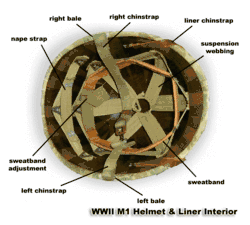
Construction
The liner is a hard hat-like support for the suspension, and is designed to fit snugly inside the steel shell.
The first liners were produced in June 1941 and designed by Hawley Products Company.[12] The suspension was initially made from strips of silver rayon webbing stretched around and across the inside of the liner. A sweatband is clipped onto these, and is adjusted to fit around the head of the wearer. Three triangular bands of rayon meet at the top of the helmet, where they were adjusted by a shoestring to fit the height and shape of the wearer's head. A snap-on nape strap cushioned the liner against the back of the wearer's neck and stops it from falling off. As the rayon had a tendency to stretch and not recover its shape, the suspension material was later changed to olive drab number 3, and then olive drab number 7, herringbone twill cotton webbing.
World War II and Korean War-era liners have their own chinstrap made from brown leather. The liner chinstrap does not have loops like the shell; it was either riveted directly to the inside of the liner (early examples) or snapped onto studs. It can still swivel inside the liner. The chinstrap is usually seen looped over the brim of the shell, and helps to keep it in place when its own chinstraps are not in use.
Early liners were made from a mix of compressed paper fibers impregnated with phenolic resin, with olive drab cotton twill fabric stretched over the outside. They were discontinued in November 1942 because they degraded quickly in high heat and high humidity environments. They were replaced by evolving plastic liners.[12], using a process developed by the Inland Division of General Motors. These liners were made of strips of cotton cloth bathed in phenolic resin and draped in a star shape over a liner-shaped mold, where they were subject to pressure to form a liner. The initial "low pressure" process was deemed unacceptable by the Army, but accepted out of need. These liners were made by St. Clair Manufacturing and Hood Rubber Company. Hawley, Hood, and St. Clair's contracts were cancelled by early 1944, when a "high pressure" process which produced better-quality liners became commercially viable. Companies which produced "high pressure" liners during World War II included Westinghouse Electric & Manufacturing Company, Firestone Tire and Rubber Company, CAPAC Manufacturing, Inland (whose molds were acquired by Firestone after their contract was cancelled), Mine Safety Appliances Company, Seaman Paper Company, and International Molded Plastics, Inc.[12]
Liners essentially identical in construction to "high pressure" World War II examples were produced between 1951 and 1954 during the Korean War by the Micarta Division of Westinghouse and CAPAC Manufacturing. In the 1960s, the M1 helmet liner was redesigned, eliminating the leather chinstrap, nape strap, and changing the suspension webbing to a pattern resembling an asterisk in a coarse cotton web material in lieu of the earlier cotton herringbone twill. In the early 1970s, suspension materials changed to a thicker, more flexible nylon with a rougher unbeveled rim. Later changes included a move to a yellow and green material for liner construction.
Paratrooper liners
M1 helmet liners intended for use by paratroopers had a different construction. The short piece of webbing which held the nape strap at the back of the wearer's neck was extended around the sides of the liner, and terminated on each side in "A" shaped yokes which hung down below the rim of the liner and had buckles for an adjustable chin cup made of molded leather. Two female snaps on the inside of the liner above the "A" yokes accepted male snaps on each of the steel shell's chinstraps, and helped to keep the liner inside the steel shell during abrupt or violent movements.
Accessories
Cover
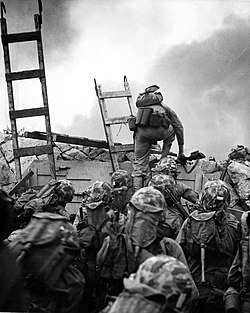
In late 1942, the United States Marine Corps used a cloth helmet cover with a camouflage pattern for its helmets. The cover was made from cotton herringbone twill fabric. It had a "forest green" pattern on one side and a "brown coral island" pattern on the other.
The United States Army often utilized nets to reduce the helmets' shine when wet and to allow burlap scrim or vegetation to be added for camouflage purposes. Most nets were acquired from British or Canadian Army stocks or cut from larger camouflage nets. The Army did not adopt an official issue net until the "Net, Helmet, with Band" that included an elastic neoprene band to keep it in place.
After World War II, various styles of camouflage cover were used at different times. In the 1960s through 1970s, the type commonly seen in the United States Army and Marine Corps was a reversible fabric cover called the Mitchell Pattern, with a leafy green pattern on one side and orange cloud pattern on the other. This type was nearly omnipresent in Vietnam, and where, for the first time, the Army wore the cloth camouflage as general issue. In Vietnam, the green portion of the reversible fabric camouflage was normally worn outermost. Helmet covers in the (European) woodland camouflage, were designed for fighting in the European Theater of Operations (NATO), and became the post-Vietnam (jungle pattern) camouflage cover used by the US military from the late 1970s onward. The (European) Woodland pattern was not reversible; they were only printed on one side, though some rare desert camouflage examples do exist. These covers were all constructed from two semi-circular pieces of cloth stitched together to form a dome-like shape conforming to the helmet's shape. They were secured to the helmet by folding their open ends into the steel pot, and then placing the liner inside, trapping the cloth between the pot and the liner. An olive green elastic band, intended to hold additional camouflage materials, was often worn around the helmet to further hold the cover in place.
Other armies used these or similar covers printed with different camouflage patterns, or employed entirely different methods. In the Dutch Army, for example, it was common practice to use a square piece of burlap as a helmet cover on M1 helmets, usually secured by a net (see above) and a wide rubber band.
During the Battle of the Bulge and Korean War, soldiers made white helmet covers as camouflage in snowy areas. They were not issued to soldiers, so many soldiers simply made them from a white cloth from a shirt or tablecloth.
Users
Current














Former
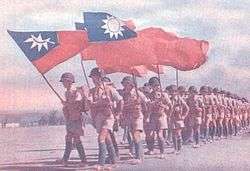
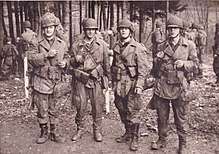

.svg.png)

.svg.png)

.svg.png)

.svg.png)










.svg.png)


















.svg.png)

.svg.png)
See also
- M1C helmet
- Modèle 1951 helmet
- Iraqi M80 helmet
References
- "M-1 Steel Helmet".
- COMBAT-HELMETS. "Schlueter Vs McCord". nuke.combat-helmets.com.
- "M1917 A1 Helmets". US Militaria Forum. Retrieved July 12, 2016.
- Stanton, Shelby L., U.S. Army Uniforms of World War II, Stackpole Books, 1995, ISBN 0-8117-2595-2, url:, pp. 57–58
- Hartzog, William W., American Military Heritage, url:, p. 224
- Tenner, Edward, and Edward Tenner. Our own devices: The past and future of body technology. New York: Alfred A. Knopf, 2003, p.252
- Giles, Marc (2018). "M1 Helmet Lot Numbers". Military Collector and Historian. 70 (3): 258.
- Giles, Marc (2018). "M1 Helmet Lot Numbers". Military Collector and Historian. 70 (3): 260.
- "Dating the M1 Steel Helmet". www.hardscrabblefarm.com. Retrieved 2019-05-05.
- Tagliavini, Michele. "STAGE AND SCREEN In all those Hollywood war films, and in quite a few newsreels, the GIs wear helmets but never fasten the straps. Is this bravado, bad discipline or artistic licence?". The Guardian. London. Retrieved 8 March 2013.
- Pike, John. "M1 Steel Combat Helmet and Liner". GlobalSecurity.org. GlobalSecurity.org. Retrieved 8 March 2013.
- Giard, Regis (2008). Helmets of ETO: A Historical and Technical Guide. Havertown, PA: Casemate Publishers. p. 12. ISBN 9782352500629.
- "Colombia".
- "Dominican Republic".
- "India M1". Brendon's Helmets.
- http://brendonshelmets.weebly.com/iran-m62.html
- "Guatemala".
- Ministry of Defense (Japan) (2014-04-23). "Ministry of Defense specification sheet, LINER, GROUND TROOPS' HELMET" (PDF) (in Japanese).
- Ministry of Defense (Japan) (2014-03-28). "Ground Self-Defense Forces Dress Manual" (PDF) (in Japanese).
- 66式 鉄帽. rightwing.sakura.ne.jp (in Japanese).
- "Panama".
- "Composite Helmet, Ballistic helmets, Military helmets KOREA, SOUTH KOREAN HELMET helmet, Kevlar helmet". www.gostak.co.uk.
- "Uruguay".
- "Argentina".
- "US Camouflaged Helmet Cover : South Vietnam". Australian War Memorial.
- ""Euroclones" - An essentiel collector's guide". OCAD Militaria Collectors Resources.
- "Brazil".
- "Bolivia".
- http://www.mpmuseum.org/securhelmet.html
- "Chile M1". Brendon's Helmets.
- "Taiwan M1". Brendon's Helmets.
- "Costa Rica".
- "Cuba".
- "Ecuador".
- "El Salvador".
- "Greek M1". Brendon's Helmets.
- "Haiti".
- "Honduras".
- https://wwiiafterwwii.wordpress.com/2016/10/16/wwii-weapons-in-the-ayatollahs-iran/
- "Israel M1". Brendon's Helmets.
- "Israeli M1 steel helmet Yom Kippur War 1973 - Collectors Weekly". www.collectorsweekly.com.
- "Mexico M1". Brendon's Helmets.
- "New Zealand M1". Brendon's Helmets.
- "Nicaragua".
- "Paraguay".
- "Peru M1". Brendon's Helmets.
- "Peru".
- "Phil. Marines PASGT helmet". www.oocities.org.
- "Saudi M1". Brendon's Helmets.
- "Singapore M1". Brendon's Helmets.
- "Turkey M1 Airborne". Brendon's Helmets.
- http://www.alliedflightgear.com/USAAF%20flak%20helmets.html
- Webster, Donovan. "How the Military Helmet Evolved From a Hazard to a Bullet Shield".
- "Venezuela M1". Brendon's Helmets.
- "Venezuela".
- "West Germany M1". Brendon's Helmets.
- Lucy, Roger (January 2015). ""Euroclones": An essential guide to postwar steel helmets". OCAD Militaria Collectors Resource. Retrieved 26 November 2016.
- Armold, Chris (1997). Steel pots: the history of America's steel combat helmets (1st ed.). San Jose, Calif: R.James Bender Pub. ISBN 091213870X.
- Oosterman, Pieter (2010). The M-1 helmet of the World War II GI: a reference based on the M-1Helmet.com collection. Atglen, PA: Schiffer Publishing. ISBN 9780764336638.
- Giard, Régis; Blais, Frederic (2007). Helmets of ETO: a historical and technical guide. Paris, France : Histoire & Collections. ISBN 9782352500629.
- Reynosa, Mark A. (1996). The M-1 helmet: a history of the U.S. M-1 helmet in World War II. Atglen, PA: Schiffer Publishing. ISBN 0764300741.
- Reynosa, Mark A. (1999). Post- World War II M-1 helmets: an illustrated study. Atglen, PA: Schiffer Publishing. ISBN 076431033X.
External links
| Wikimedia Commons has media related to M1 helmets. |
- "steel helmet, pattern M1, with liner, US Army". Ukniwm.org.uk. Retrieved 7 December 2017.
- "Steel Helmet, 'Talker' MKII: US Navy". Ukniwm.org.uk. Retrieved 7 December 2017.